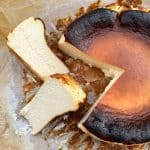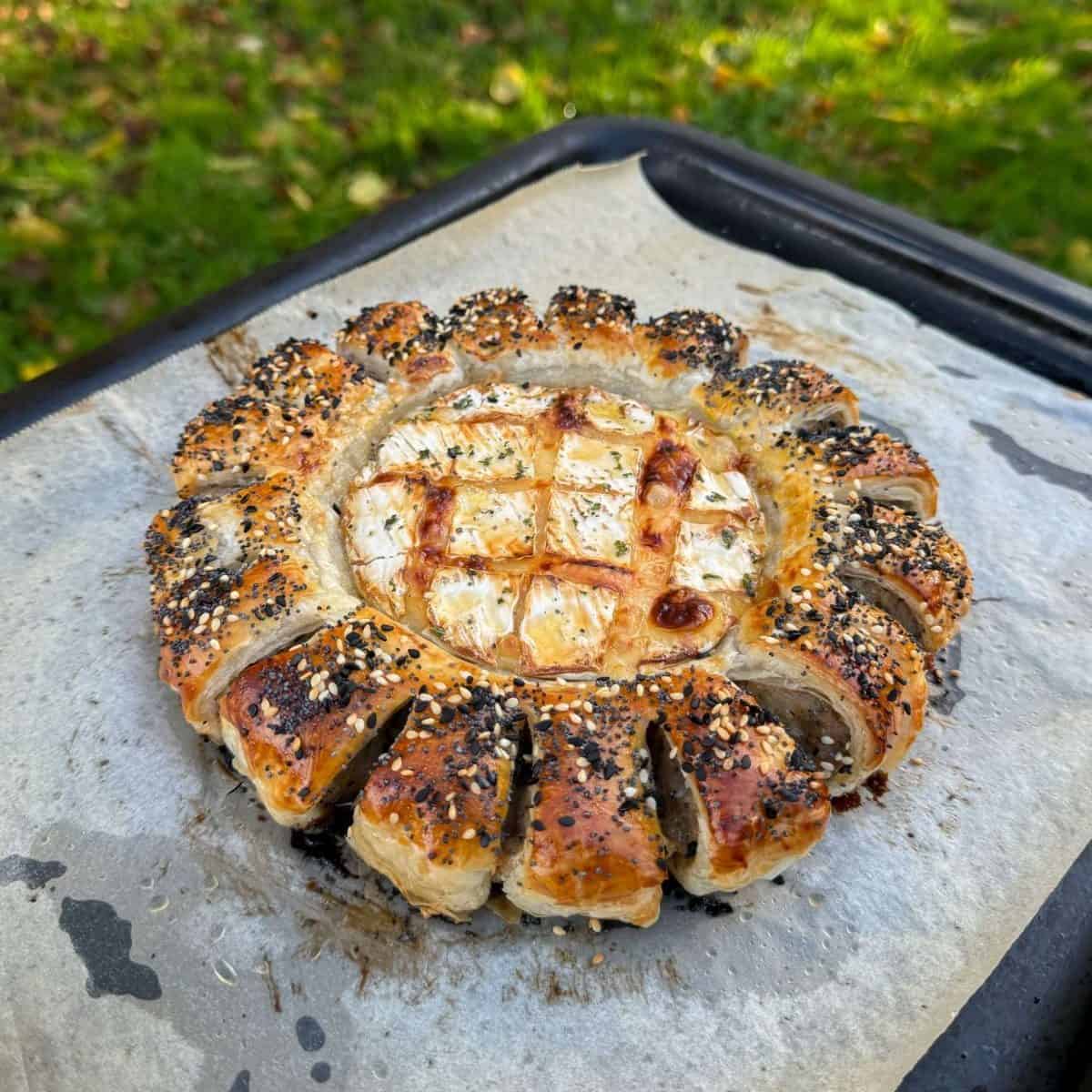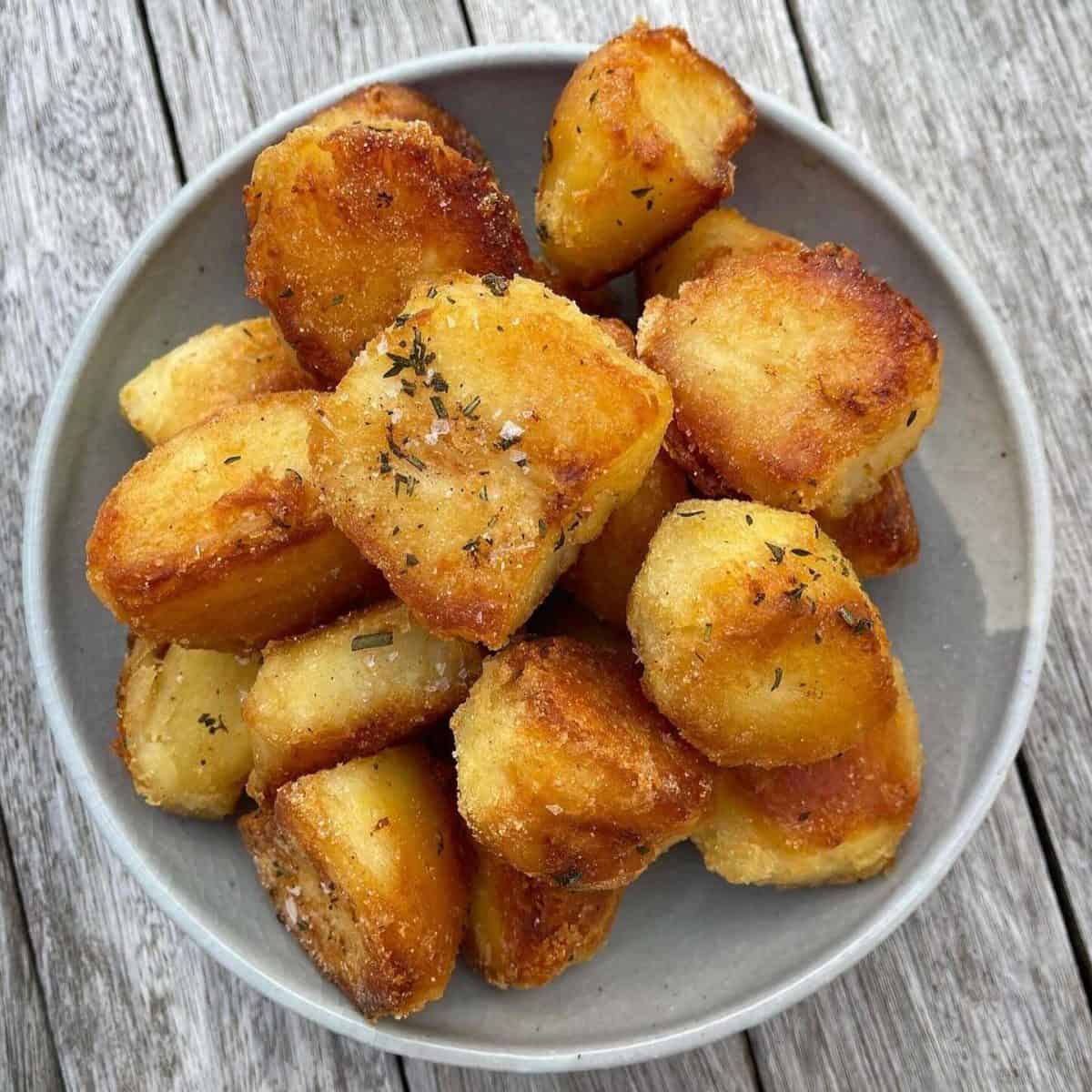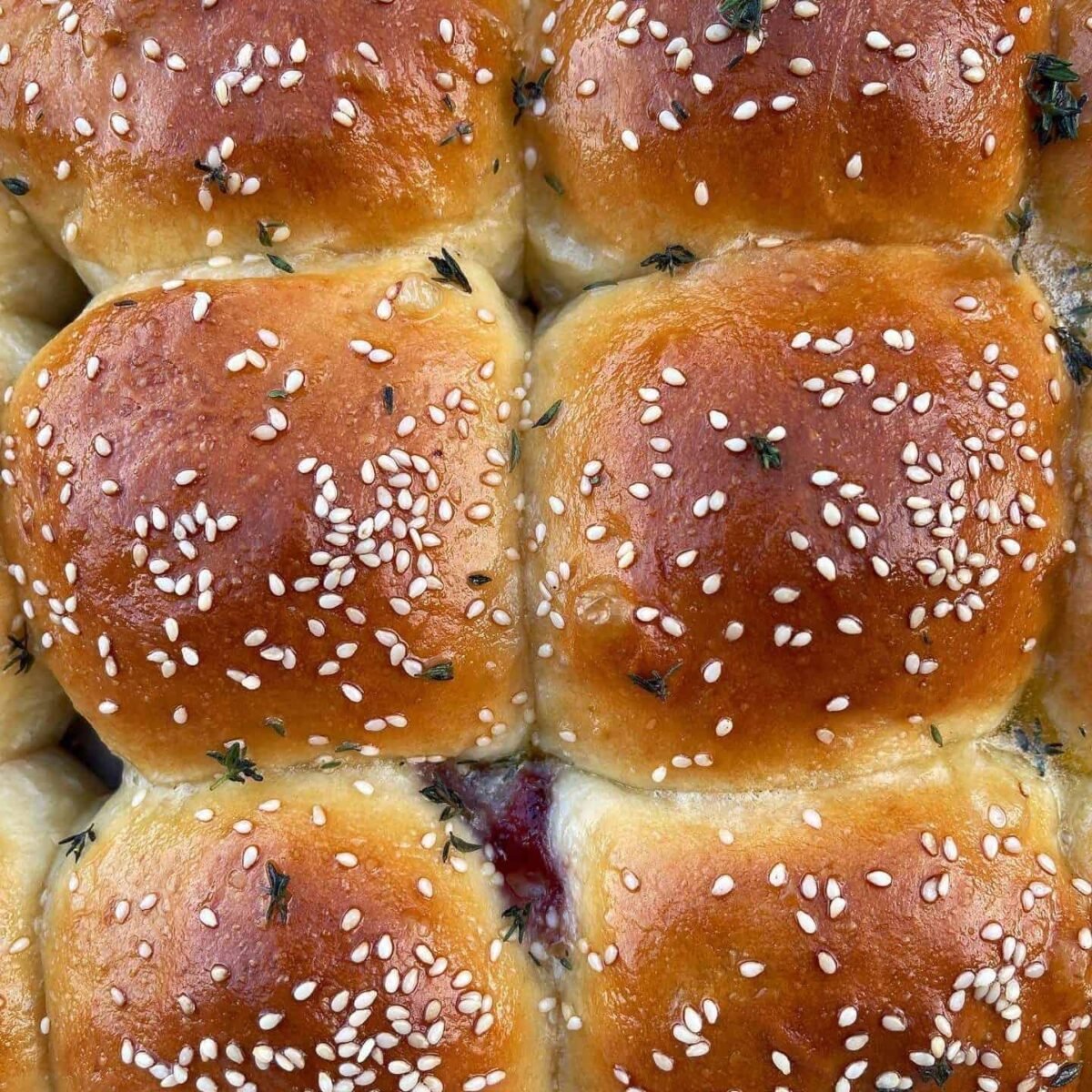Baileys Basque Cheesecake
This Baileys Basque cheesecake is a festive twist on the San Sebastián classic. It’s incredibly creamy & has a beautifully burnt exterior.
This post contains affiliate links.
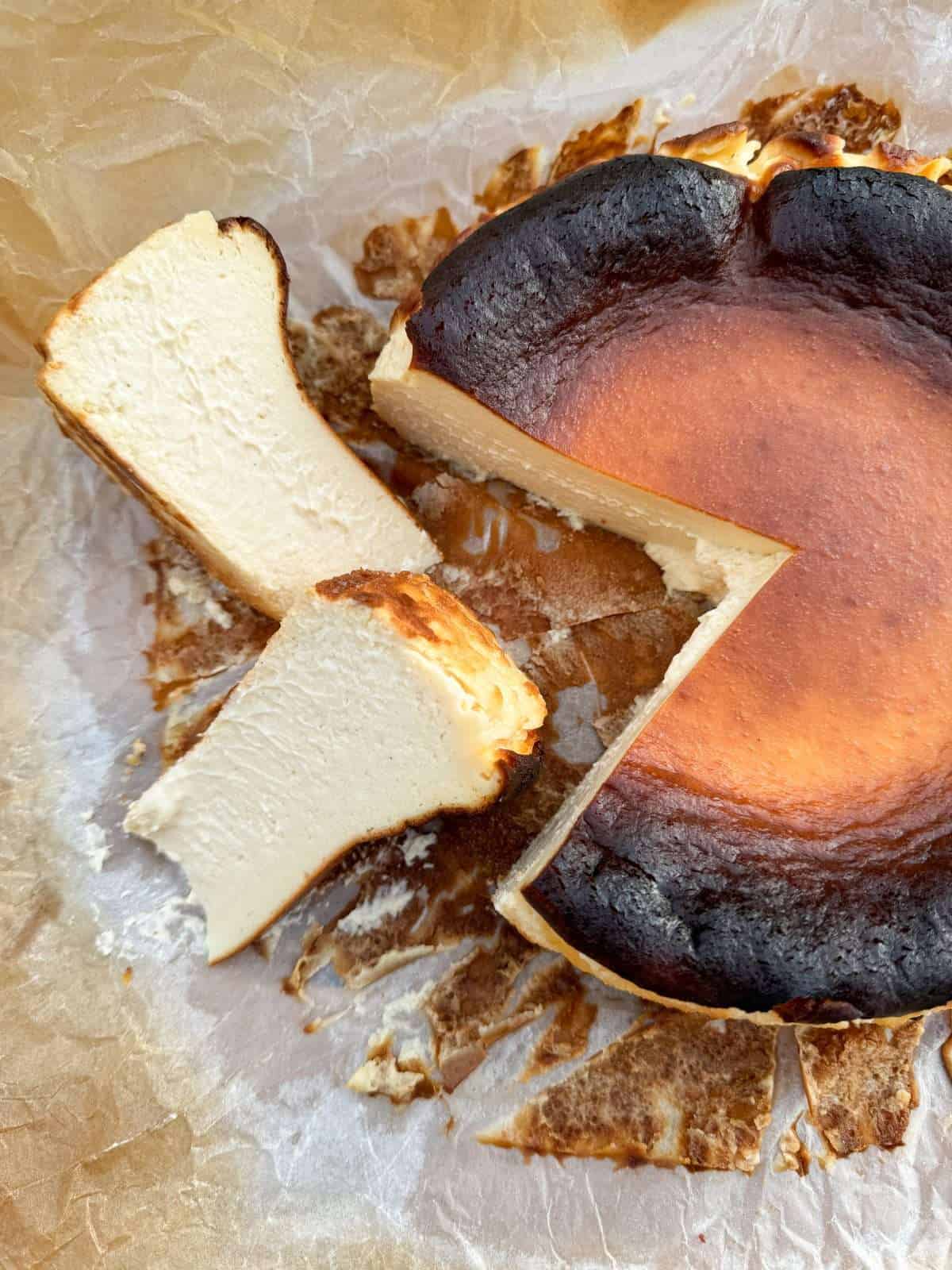
I’ve given a classic Basque burnt cheesecake a festive twist by flavouring it with Baileys Irish cream! This San Sebastian cheesecake has a perfectly burnt top & an incredibly rich & luxurious middle. It’s almost impossibly creamy!
This Baileys Basque cheesecake has all the qualities of a classic burnt Basque cheesecake but with a hint of Baileys, for an extra festive flavour. It’s creamy, decadent & delicious! That deeply caramelised crust really does help cut through all that dairy & don’t worry, it’s meant to be burnt! This would make a fantastic alternative to your classic Christmas desserts & is best served on its’ own so you don’t have to worry about finding something to serve it with.
The Creamiest Basque Cheesecake!
I’ll be honest, this Basque cheesecake has taken me a while & several batches to get right, mainly as I’ve been trying to make it as creamy as possible (and I dropped one whilst filming it)! Although even when Basque cheesecake isn’t 100% perfect it’s still delicious.
In order to make the creamiest Basque cheesecake, you need to cook it in a super hot oven for a short amount of time. We’re aiming to overcook the top & undercook the middle. It’s all about finding the perfect balance! We’re also adding creme fraiche into the cheesecake batter for extra creaminess & a subtle tanginess, as well as extra egg yolks for richness.
What You’ll Need
- Baileys – The star of the show! Baileys is an Irish cream liqueur that’s made with whiskey & cream. This can be found in most supermarkets & tends to be enjoyed at Christmas.
- Cream Cheese – For the creamiest cheesecake, you’ll need to use a full fat cream cheese. I use Philadelphia. For this recipe, you’ll need 560 grams of cream cheese, which is 2 large tubs of Philadelphia.
- Creme Fraiche – Adding creme fraiche to our Basque cheesecake adds a subtle tangy flavour which helps cut through all that rich, creamy dairy!
- Double Cream – We’re using double/heavy cream for this recipe, for the creamiest flavour & texture.
- Sugar – Caster sugar works best for Basque cheesecake as it has finer granules which means that it dissolve easier. It also has a more neutral flavour, so it adds sweetness whilst letting the flavour of the Baileys shine through.
- Eggs – For this cheesecake, we’re using a combination of whole eggs & egg yolks. You’ll need to measure out 240 grams of whole eggs & 35 grams of yolks. This roughly equates to 4 large eggs & 2 yolks.
- Cornflour – Adding cornflour (or plain flour) into the cheesecake batter helps stabilise the cheesecake & means that the liquid in the filling won’t “weep” after the cheesecake has been refrigerated (this tends to happen the day after baking).
- Vanilla – Some good quality vanilla paste adds an extra layer of flavour to this cheesecake. Vanilla pairs really well with Baileys!
- Salt – Adding a generous amount of sea salt to our Basque cheesecake helps enhance its’ flavour. I use Maldon salt.
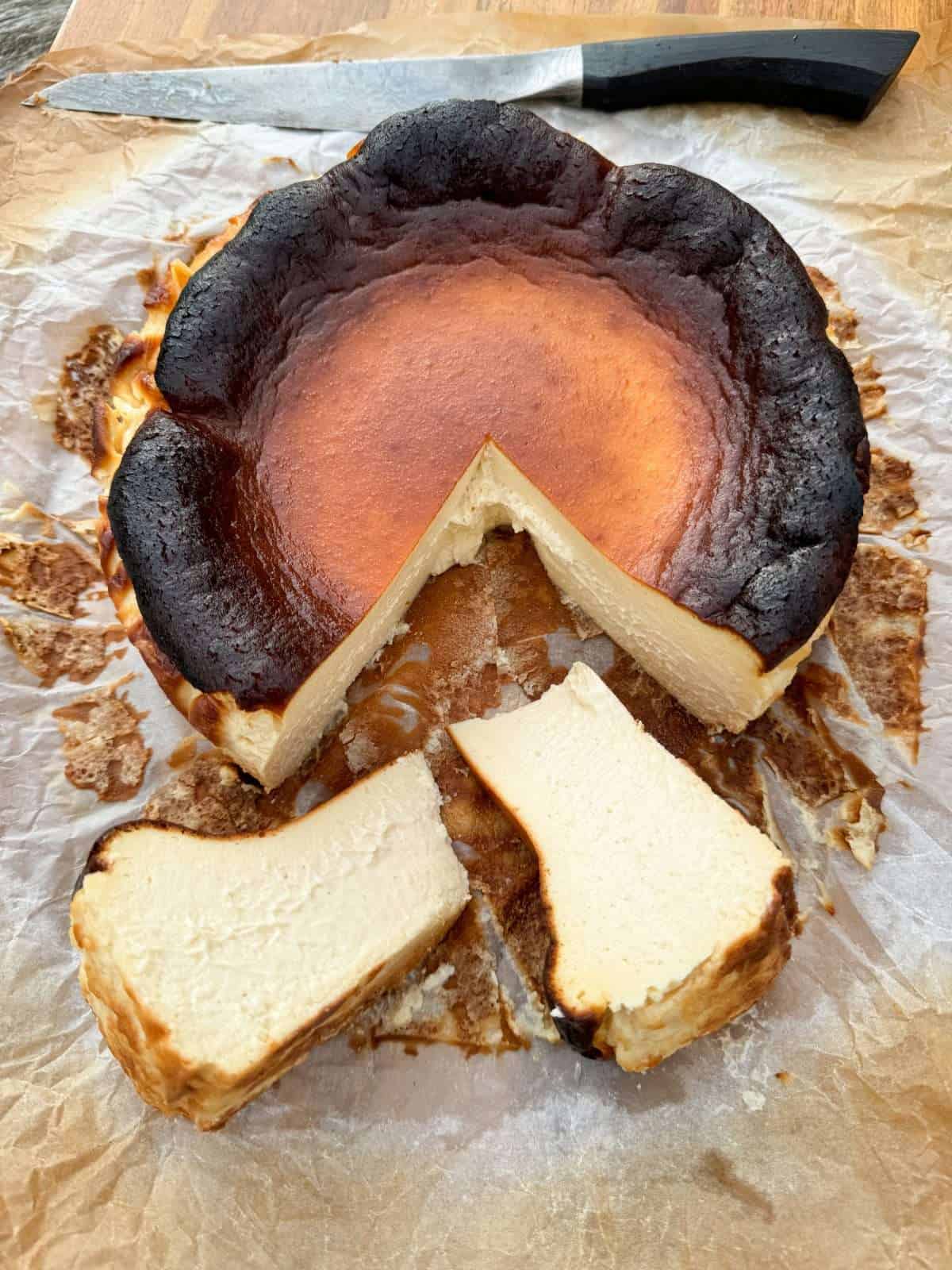

How To Make Baileys Basque Cheesecake
The full, printable recipe card for this cheesecake can be found at the bottom of this post! Here’s a quick rundown of the recipe…
How To Line A Tin For Basque Cheesecake
Lining a tin for basque cheesecake is super easy! You’ll need to use a springform tin for basque cheesecake, otherwise you’ll struggle getting it out once set.
To line a springform tin for basque cheesecake, simply take a large piece of baking parchment, scrunch it up with your hands then unravel & press into the tin. There should be at least an inch of parchment overhanging the edge. Don’t worry if the parchment doesn’t sit perfectly in the tin, as the batter will weigh it down! Also, there’s no need grease the tin.
Once lined, place your tin onto a baking tray & set aside (placing the tin on a tray makes it easier to take it out of the oven).
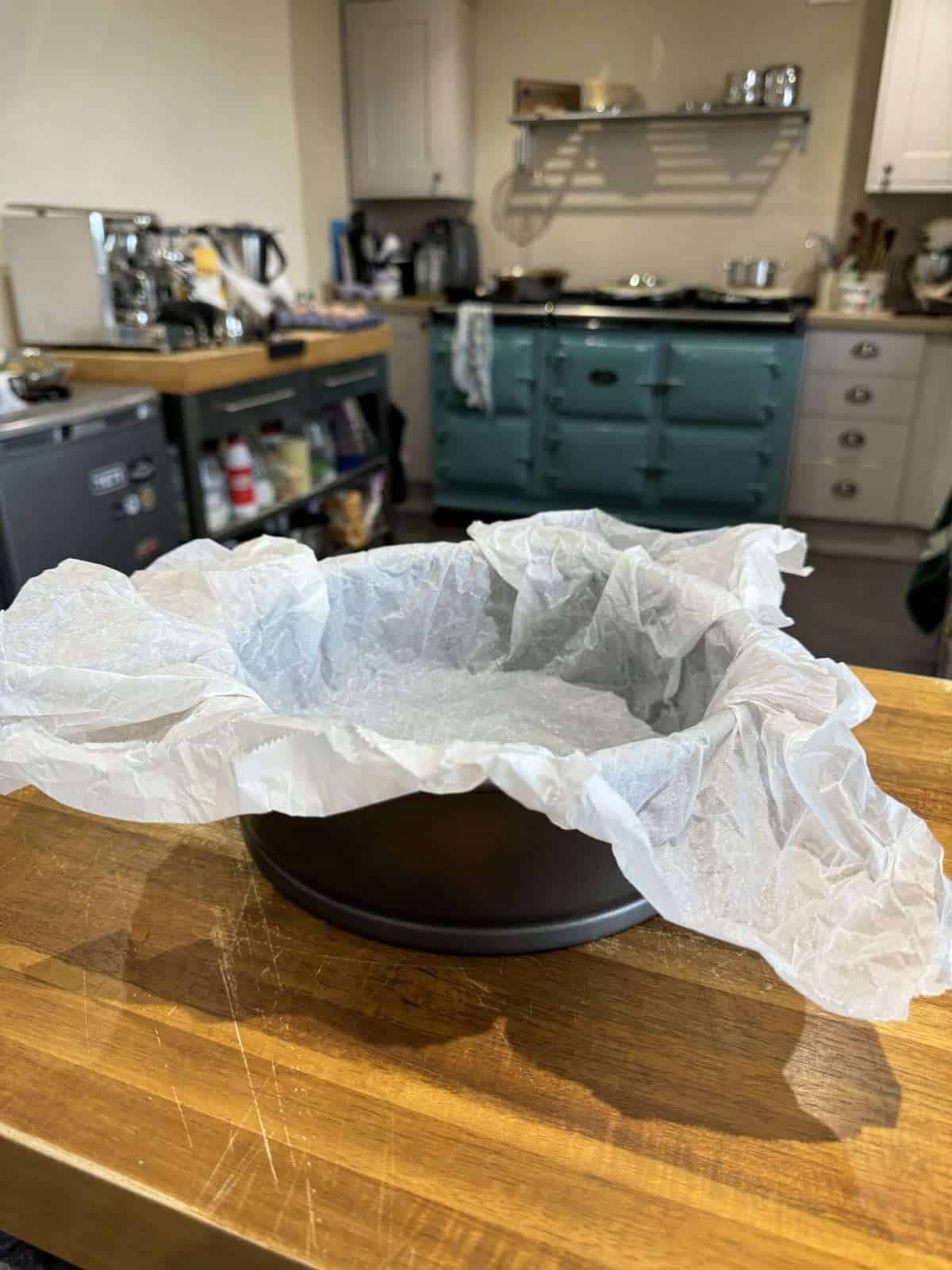
Basque Cheesecake Batter
Before making the cheesecake batter, it’s key to make sure that the cream cheese, creme fraiche & eggs are all at room temperature. You’ll need to let them sit out for an hour or so before using.
Making the batter for basque cheesecake is super easy to make. I like to use a stand mixer for this but you could use an electric hand mixer or even mix the batter by hand (with a spatula/wood spoon). However you mix it, it’s important that you scrape the sides of your mixing bowl down regularly, so you get an evenly mixed, smooth batter.
- Mix Cream Cheese & Sugar
First, we add cream cheese, creme fraiche, caster sugar, vanilla paste & sea salt into the bowl of a stand mixer then beat on a low speed for 2-3 minutes, until smooth & combined. - Add Eggs
Once the cream cheese is smooth, we mix the eggs & yolks into the batter, one at a time whilst still mixing on a low speed. - Cornflour & Cream
Next, we add cornflour into a separate bowl then gradually pour in the double cream, whilst whisking, to make a smooth paste. Make sure not to over whisk the cream though! - Add Baileys
With the mixer still running on a low speed, we gradually pour in the cornflour & cream mix, followed by the Baileys. - Pass Batter Into Tin
Once mixed, we pass the batter through a sieve, into the lined tin. Then to remove any air bubbles, we tap the tin firmly on a work surface. If there’s any stubborn bubbles on top that won’t pop, run a knife through the batter to get rid of them.
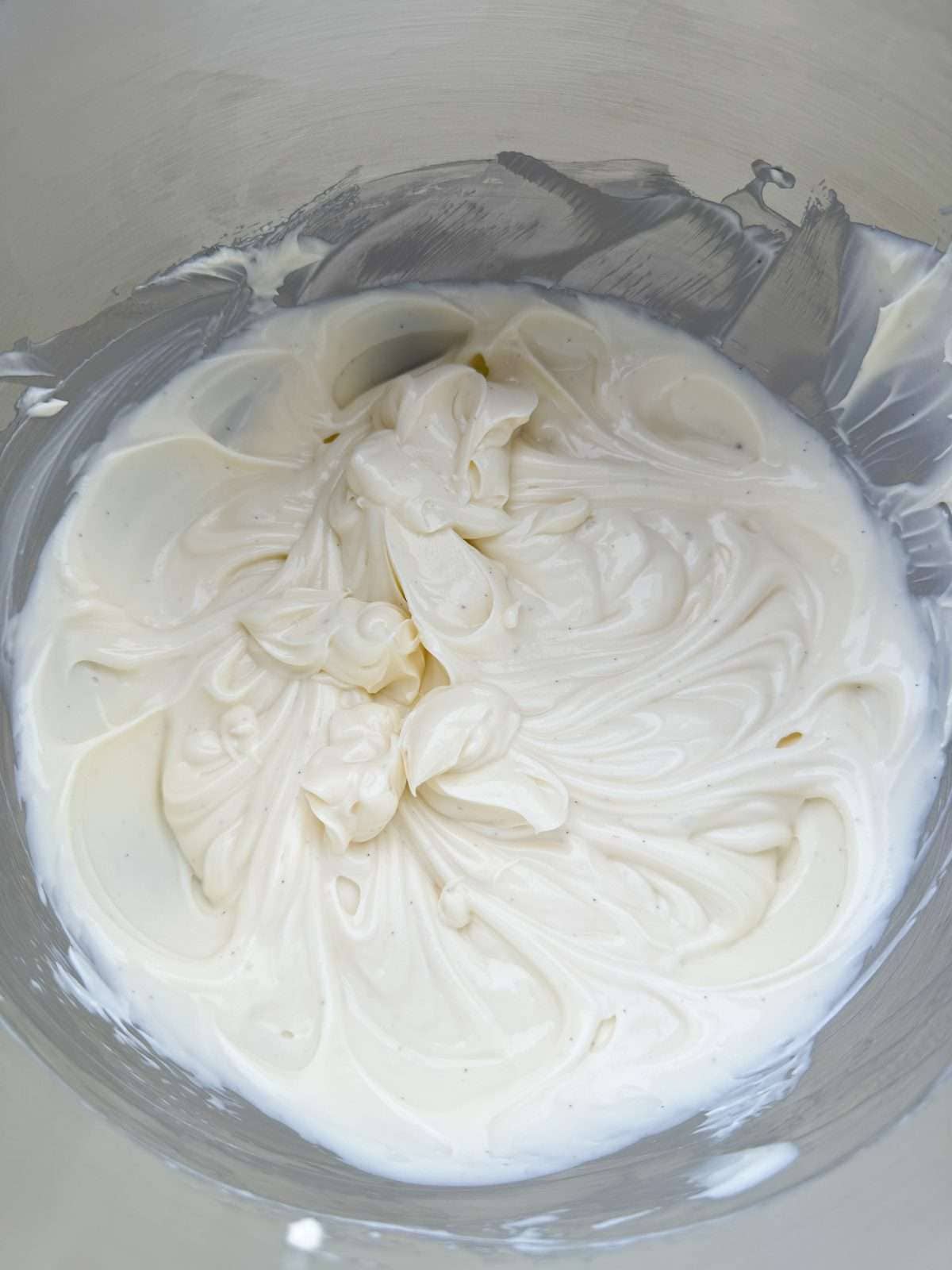
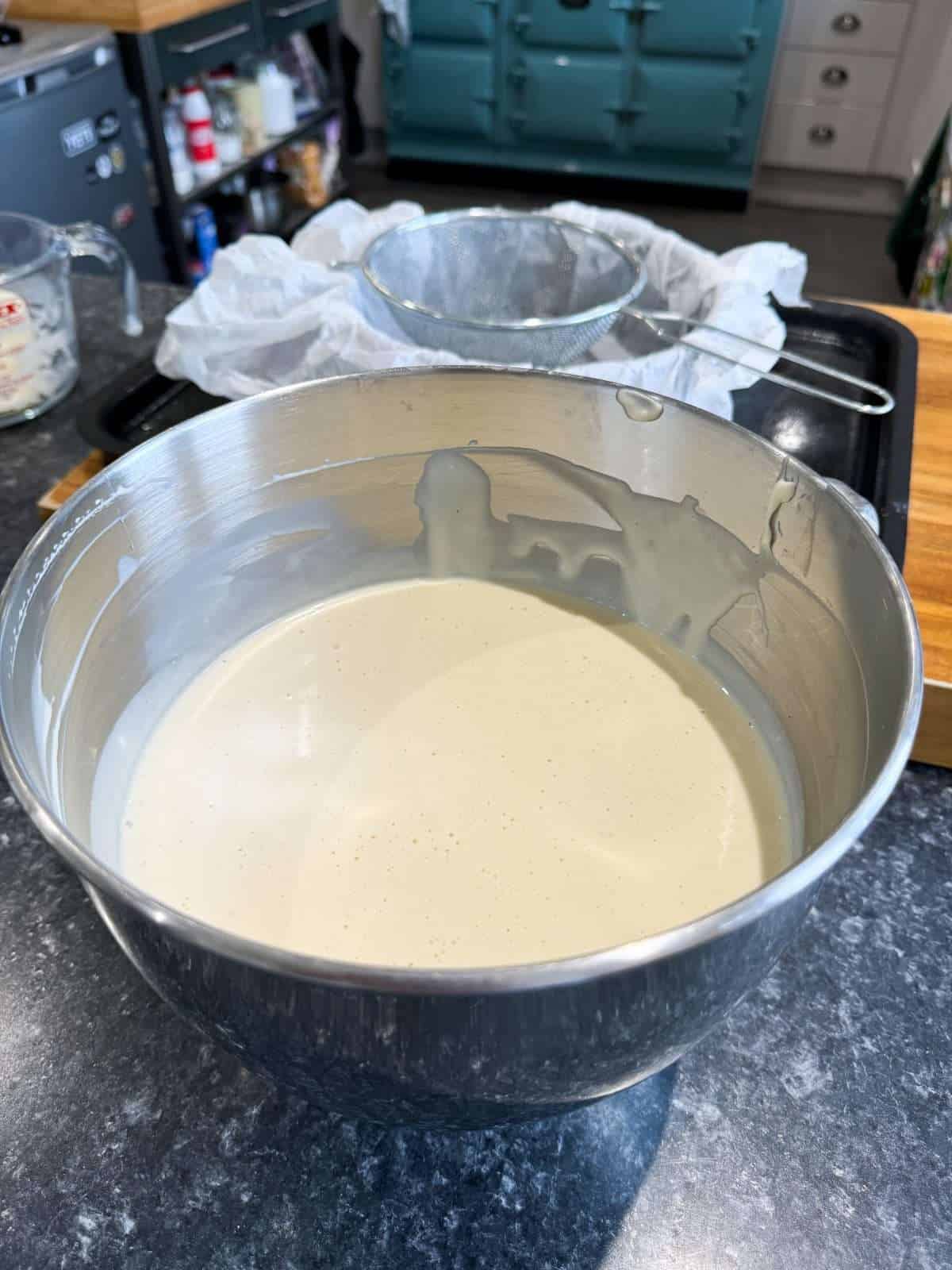
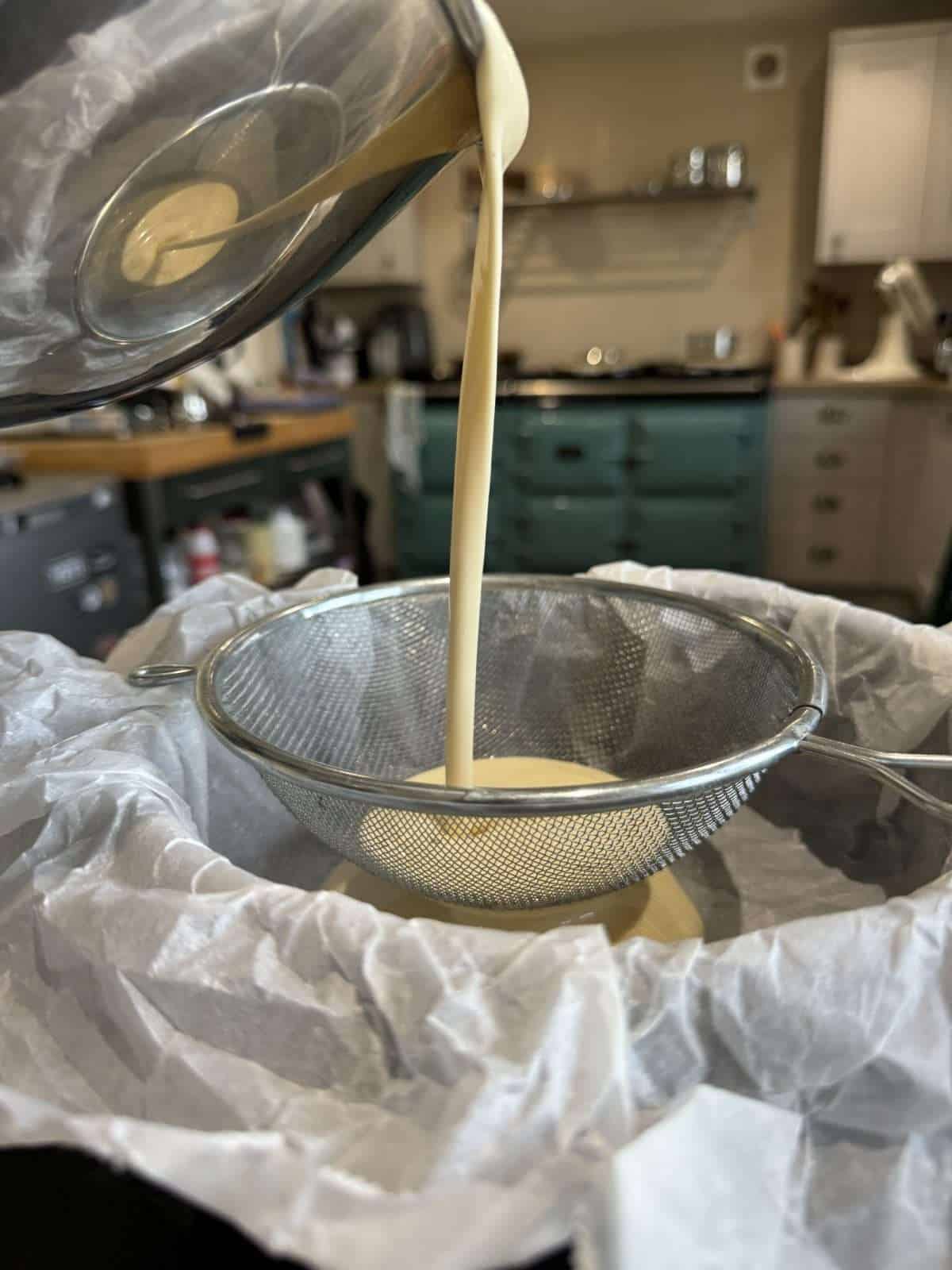

How To Cook Basque Cheesecake
To make the creamiest Basque cheesecake, we need to cook it “hot and fast”. This means cooking it at a high temperature for a short amount of time. This is the traditional way to bake Basque cheesecake and means that the centre will be gooey & slightly underdone whereas the top will be well caramelised & almost burnt.
To cook our Baileys Basque cheesecake, we bake it for 35-40 minutes at 220°c/428°f. Once cooked, the top of the cheesecake will be a deep brown colour but will still be jiggly in the middle. If you take the internal temperature of the cheesecake with a digital food probe, it should be 60°c-65°c (140°f-149°f) once cooked.
If you prefer an extra gooey, almost runny centre, cook the cheesecake to 60°c/140°f. If you’d prefer a more evenly set cheesecake, cook it to 62°c-65°c/144°f-149°f
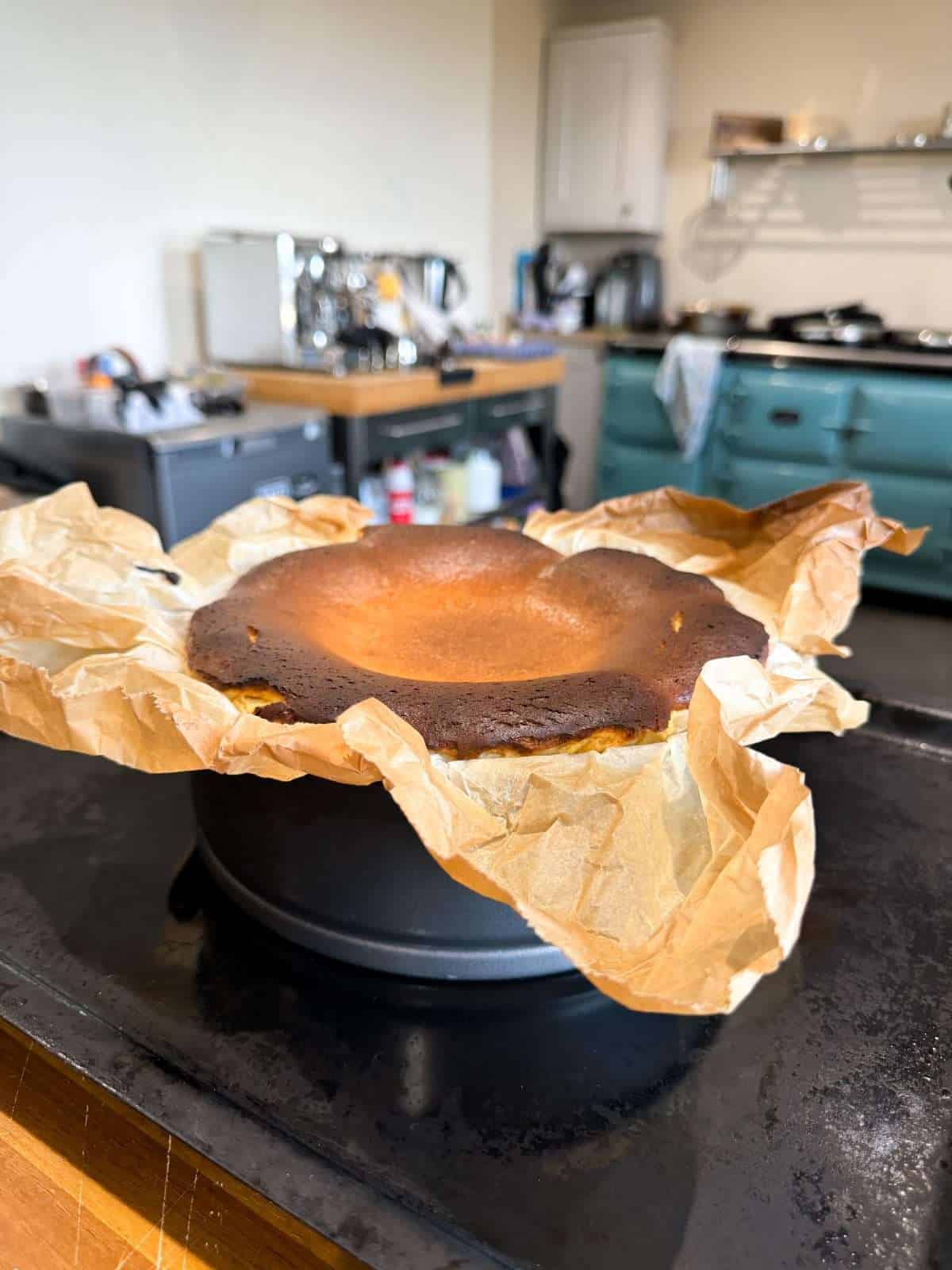
Overnight Chill – To Set
Once cooked, we let the cheesecake cool completely in the tin then chill it in the fridge for at least 12 hours, to give it plenty of time to set properly. The basque cheesecake will have risen in the oven but will sink as it cools. This is normal!
To Serve
Before serving your cheesecake, I’d recommend letting it sit out of the fridge for an hour. Basque cheesecake is best served at room temperature as it’ll be at it’s creamiest!
To serve your Baileys Basque cheesecake, carefully remove it from the tin then fold back the baking parchment. Then cut your cheesecake into slices with a knife that has been dipped in hot water & dried between cuts.
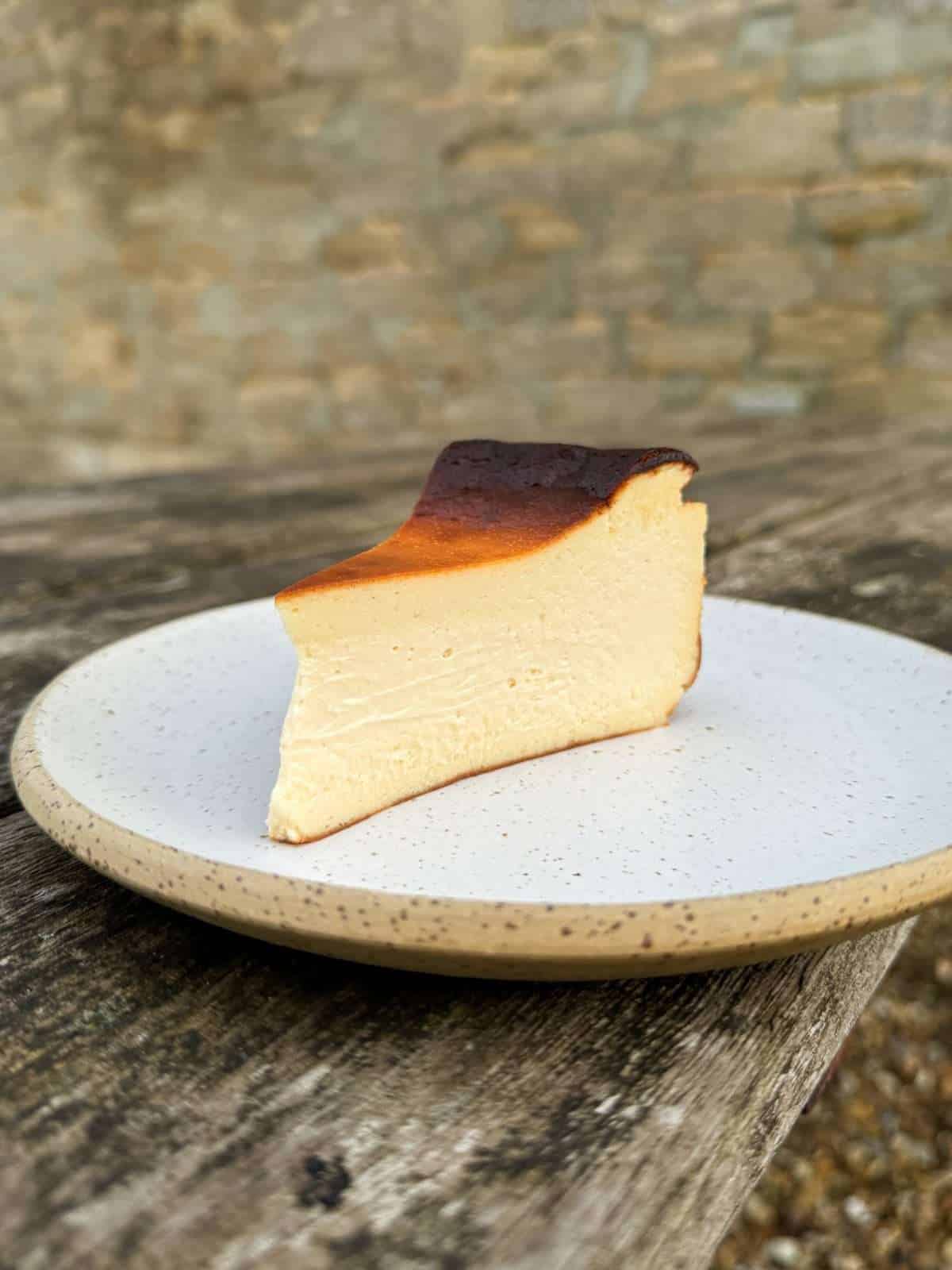
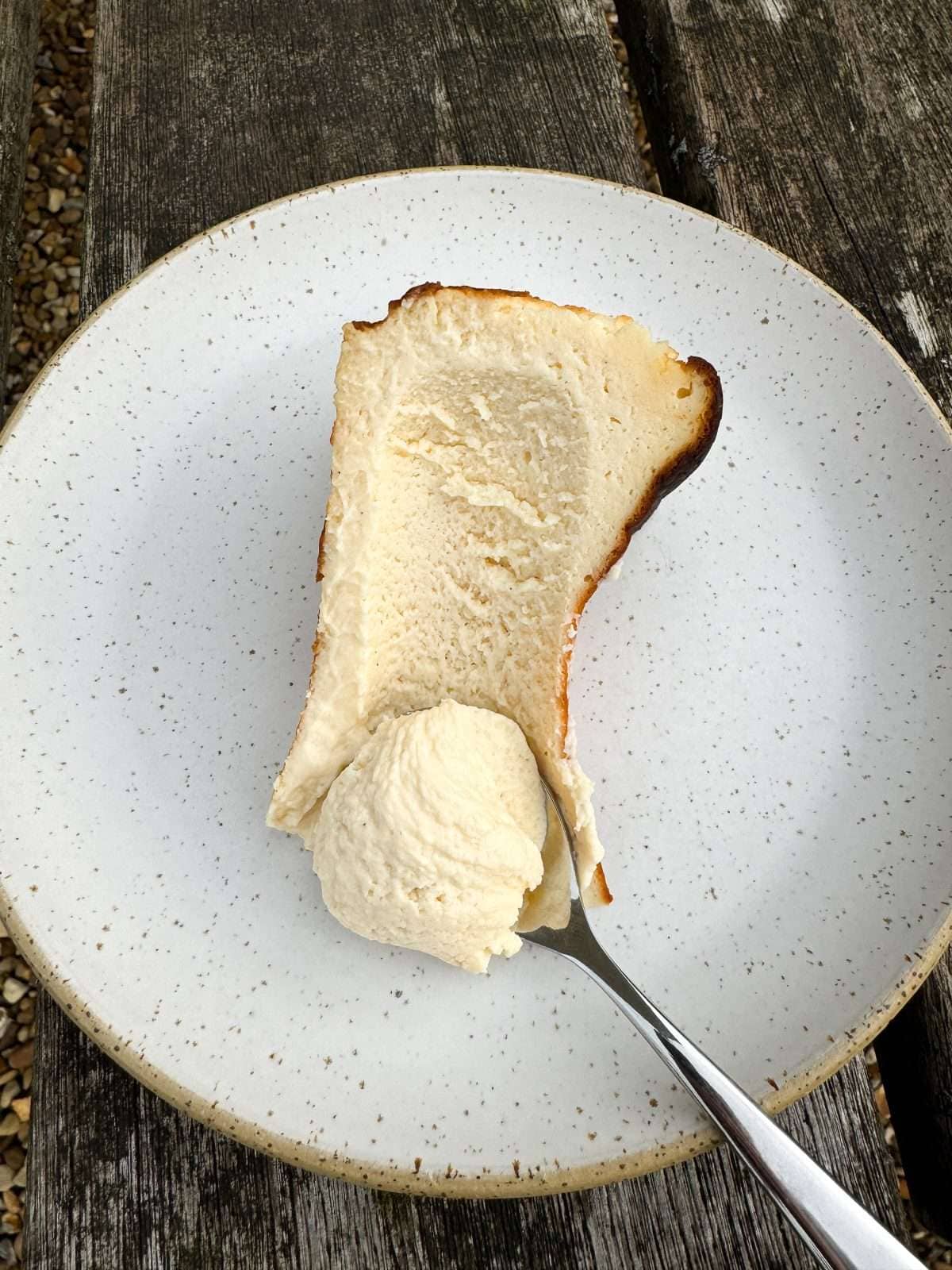
Tips & Tricks
- Make sure that your ingredients are at room temperature, so that the batter mixes properly. This is key to making a smooth cheesecake.
- Mix the batter on a low speed (if you’re using a stand mixer), to avoid incorporating too much air as this can make the cheesecake less creamy & crack on top.
- Bake your cheesecake “hot and fast” for the creamiest texture. This means cooking the cheesecake at a high temperature for a short amount of time.
- Let your basque cheesecake chill in the fridge for at least 12 hours, so that it sets properly.
- Serve your cheesecake at room temperature. This is when basque cheesecake has the creamiest texture.
- To portion the cheesecake, use a knife that has been dipped in warm water & dried between cuts. This is how you get the cleanest slices!
Frequently Asked Questions
The best way to tell when a basque cheesecake is cooked is by its’ appearance. Once cooked, your basque cheesecake should be a deep, brown colour on top but still jiggly in the middle. If you take the internal temperature of the cheesecake, it should be between 60°c-65°c (140°f-149°f).
In order to set properly, basque cheesecake needs to be refrigerated for at least 12 hours.
Basque cheesecake is best served at room temperature. I’d recommend letting your cheesecake sit out of the fridge for an hour before serving.
Using a stand mixer makes mixing the Basque cheesecake batter easier but it can be done without one. You could mix the batter by hand or use an electric hand mixer.
Basque cheesecake is meant to be a deep brown colour on top that’s really well caramelised & pretty much burnt. However, not all ovens will brown basque cheesecake evenly so you might have to turn it around halfway through cooking. Even if yours cheesecake isn’t evenly browned all over, it will still taste great!
How To Cook A Basque Cheesecake In An Aga
With all of my recipes, I include cooking instructions for conventional ovens, fan ovens & also Agas. Here’s how to cook this recipe in an Aga…
Bake the basque cheesecake on a grid shelf placed on the floor of the roasting oven. Turn the cheesecake around after 30 minutes so that the top browns evenly.
Equipment Used
Please note that these are affiliate links & I may make a small commission if you make a purchase using these links, at no extra cost to you. For more information, click here.
More Christmas Desserts To Try!
- Mince Pie Panettone Treacle Tart
- Deep Fried Mince Pies
- Individual Christmas Baked Alaskas
- Christmas Pudding & Brandy Butter Ice Cream
- Baileys Mince Pie Ice Cream
- Baileys Vanilla Rice Pudding
If you have enjoyed this Baileys basque cheesecake recipe, it would mean a lot if you could leave a review & rating. And if you’d like to stay up to date with future recipes, follow us on Instagram & TikTok!
Baileys Basque Cheesecake
Equipment
- 8" Springform Tin (See Notes)
- Baking Tray
- Stand Mixer
- Mixing Bowl
- Sieve
- Digital Food Probe
Ingredients
- 560 g Cream Cheese (At Room Temperature)
- 240 g Creme Fraiche (At Room Temperature)
- 230 g Caster Sugar
- 2 tsp Vanilla Paste
- ½ tsp Fine Sea Salt
- 240 g Whole Eggs (4 Large Eggs – At Room Temperature)
- 35 g Egg Yolks (2 Egg Yolks – At Room Temperature)
- 30 g Cornflour
- 250 g Double Cream
- 150 g Baileys Irish Cream
Instructions
- Preheat an oven to 220°c/200°c fan (428°f/392°f).
- Take a large piece of baking parchment, scrunch up then press into an 8" springform tin. Make sure to leave some parchment overhanging the edge of the tin. Place the tin onto a baking tray then set aside.
- Add the cream cheese, creme fraiche, caster sugar, vanilla & salt into the bowl of a stand mixer then mix on a low speed with the paddle attachment, for 2-3 minutes, until smooth.Make sure to scrape the sides of the bowl down regularly with a spatula whilst making the batter. It's important to mix on a low speed, so that we don't incorporate too much air into the batter as this will affect the texture of the baked cheesecake.
- With the mixer still running on a low speed, mix in the eggs one at a time, followed by the yolks.
- Next, add the cornflour into a separate mixing bowl then gradually pour in the double cream, whilst whisking, to make a smooth paste. Don't over whisk the cream! Make sure to stop whisking as soon as a smooth paste has formed.
- With the mixer still running on a speed, gradually mix in the cream & cornflour, followed by the baileys. Give the sides of the bowl a final scrape down then mix again briefly, to make sure that the batter is nice & smooth.
- Next, pour the batter into the tin, through a sieve then tap the tin on your work surface a couple of times to pop any air bubbles.
- Bake the cheesecake in the preheated oven for 35-40 minutes, until it is a deep brown colour on top & is still jiggly in the centre. If you take the internal temperature of the cheesecake, it should be between 60°c-65°c (140°f-149°f)The cheesecake will have risen once cooked but will fall as it cools. This is normal! For a softer set cheesecake, cook to 60°c/140°f. For a more evenly set cheesecake, cook closer to 65°c/149°f.
- Let the cheesecake cool to room temperature (this will take a couple of hours) then refrigerate overnight (at least 12 hours).
- To serve, take the cheesecake out of the fridge & leave to sit at room temperature for an hour. Take the cheesecake out of the tin then cut the into portions. For the neatest portions, cut the cheesecake using a knife that has been run under warm water & dried between cuts. A non serrated knife works best!

